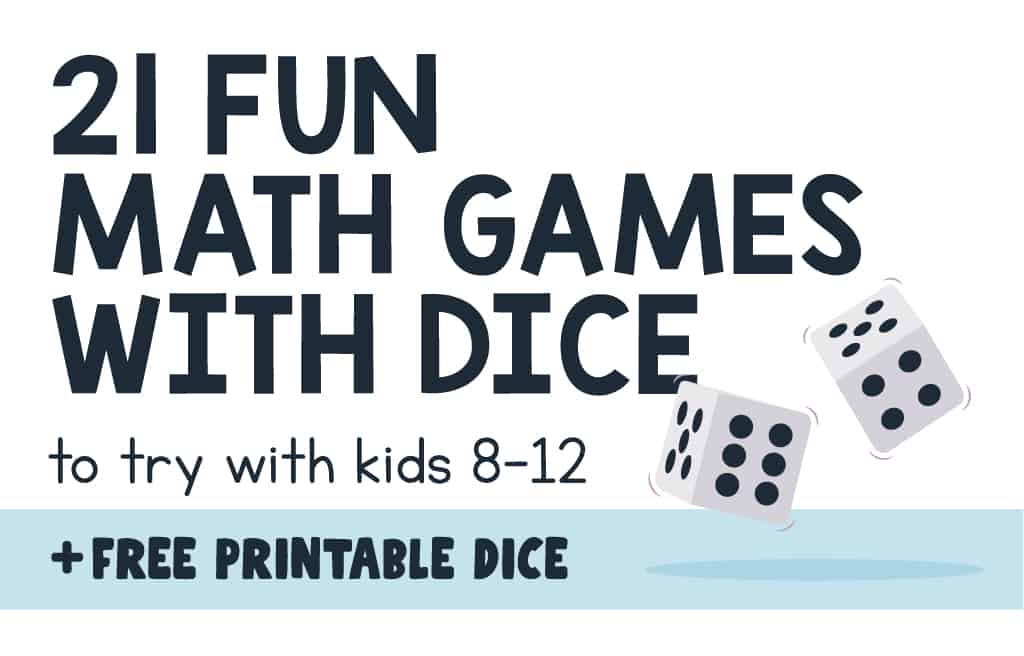21 Fun Math Games with Dice for Kids 8-12 and FREE Printable Dice
When my stepdaughter, Taylor, struggled with math during her elementary years, I discovered an effective solution: introducing her to engaging math games with dice! These games transformed her math learning experience from stressful to delightful, and I think they can do the same for your elementary learners.
Math games with dice offer a relaxed and enjoyable way for students to enhance their math skills. As an experienced Montessori elementary teacher, I’ve seen their versatility and adaptability cater to various skill levels, making them a valuable addition to any child’s learning toolkit.
💡🎲💡🎲💡
Our Top 5 Dice Sets for Kids
Set of 100 White Dice
Tenzi Dice Game
Foam Dice Set Pack of 36
10 Pack Wooden Dice Set
Classroom Dice Set
21 Fun Math Games with Dice for Kids 8-12
Explore our collection of fun dice games for kids that help elementary students learn various math skills.
💡 Teacher-Tested, Kid-Approved Dice Games
My stepdaughter loved #4, picked up great skills with #6, and nailed subtraction thanks to #12. I’ve used these games with upper elementary students, during indoor recess, and even in online classes.
Fun, easy to use, and always a hit, math games with dice are a simple way to make math more exciting. Consider this your sign to bring them into your classroom!
1. Race to 100
🔢 Working on: Addition and Quick Thinking
😀 Number of Players: 2 or more (there is a single-player option too!)
🎲 Number of Dice: 1 or 2
📝 Materials: Pencil and Paper
Race to 100 is a relatively easy dice game for kids and can be used to reinforce addition facts and promote quick thinking with numbers.
It’s a great way for kids to get excited by putting numbers together.
This fun game requires two or more players and can be played using two regular six-sided dice, scrap paper, and a pencil. Only have one die? No problem. Players can roll that one die twice.
On their turn, players roll two dice and add the two rolled numbers together to get a sum. The sum of each round equals the points for that round. Players record their sum on their paper after each turn and add it to the sum of the previous round.
The first player to reach 100 points wins the game.
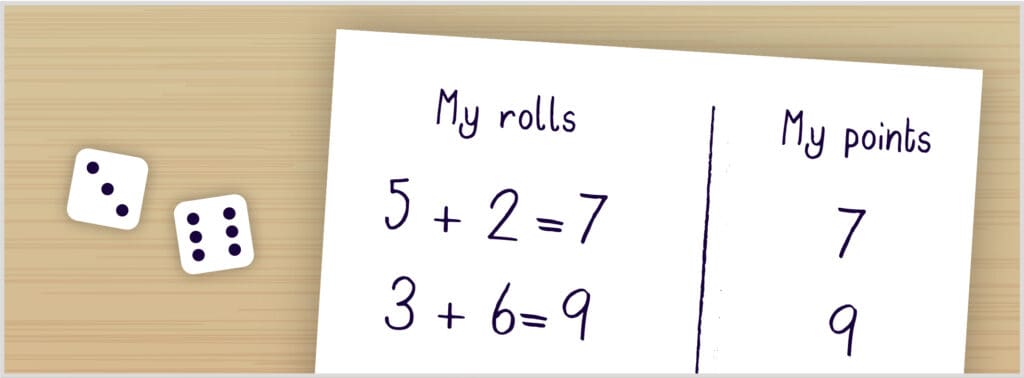
For example, if a player rolls a 5 and then rolls a 2 they add those numbers together to get a sum of 7. That player then has 7 points for that round.
If on the next round that player rolls a 3 and then a 6 their points for that round would be 9 (3 + 6 = 9). Before moving to the next round the player needs to add the sums from the two rounds together. In this case, it is 7 and 9, which gives them 16 points. It’s a slow climb to 100, but a fun and educational one at least!
Players will inch their way to 100 points while working on their addition skills while keeping track of their scores.
🎲 Sum Fun for One!
This game can be used with a single player as a fun way to practice their addition skills. Have them roll two dice and follow the same steps outlined above until they get to 100 points.
Use a timer to see how long it takes them to make it to 100.
2. Sum Type of Fun
🔢 Working on: Addition and Number Recognition
😀 Number of Players: 2
🎲 Number of Dice: 1 or 2
📝 Materials: Pencil and Paper with the numbers 2 to 12 written vertically
Sum Type of Fun is a fun math game with dice that practices basic addition skills.
For this game, players need two dice. Each player is going to need a sheet of paper with the numbers 2 to 12 written on it. Encourage players to get creative about how they show those numbers on the page.
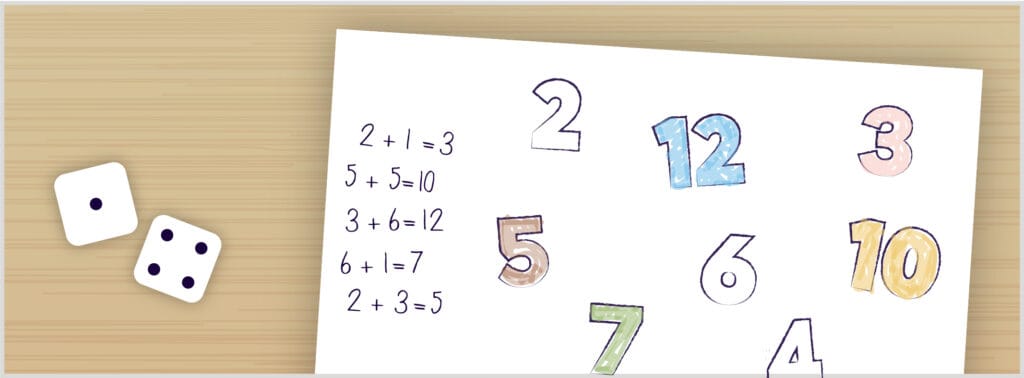
In this game, players take turns rolling two dice (or one die twice!). After rolling, they add the numbers together. Similar to bingo, they cover the sum on their number sheet using a token, coin, pencil stroke, or any item available!
The dice are then handed to the next player.
For example, if a player rolls a 1 and a 4 they need to add those numbers together to find the sum, which is 5. On their number chart, they will cover the number 5.
If the sum of a player’s roll is already covered on their number chart, then their turn is over and the play moves to the next player.
For example, if they roll a 3 and a 2 on their next turn they have a sum of 5 again. Since 5 is already covered, no numbers can be covered on this turn. Play continues with the next player.
The first player to cover up the numbers 2 to 12 wins the game.
✨ Play this game in multiple ways!
Do your students need more of a challenge? Are they older with more advanced skills? Play this game with multiplication and addition!
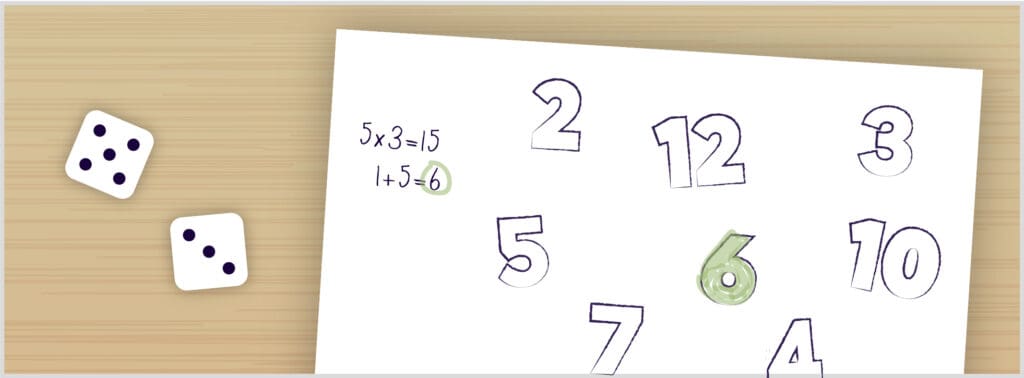
Have players list the numbers 1-9 on their paper. This time players will multiply the two numbers rolled and then add up the digits in the product.
For example, if a 3 and a 5 are rolled they would multiply 3×5 to get 15 and then add 1 + 5 to get 6. They would cover up the number 6 on their number sheet.
3. Take It Away
🔢 Working on: Subtraction and Number Recognition
😀 Number of Players: 2 or more
🎲 Number of Dice: 2
📝 Materials: Pencil and Paper with the numbers 0 to 6 written on it
To prepare for this math dice game that practices subtraction, you’ll need a pair of dice (or just roll one die twice!), as well as paper and a pencil for each player. Have players write the numbers 0 to 6 horizontally on their paper.
This game is similar and yet the opposite of Sum Type of Fun.
Players take turns rolling two dice. The player who rolled the dice will subtract the smaller number from the larger number.
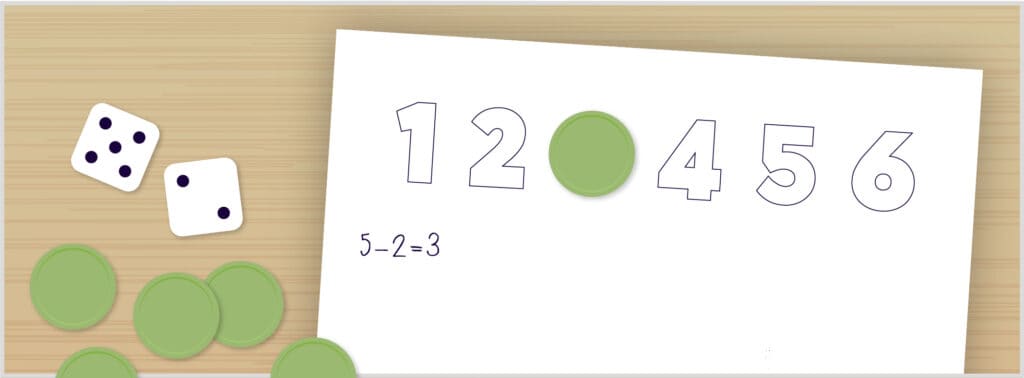
They then cover that number up on their number sheet using coins, tokens, or whatever works in your classroom. Alternatively, you could give them the option of shading their answers in.
For example, if a player rolls a 2 and a 5 they need to take away (subtract) the smaller number from the larger number. Their answer is what is left when 2 is taken away from 5. Since the answer is three, the player can colour in or cover up the number 3 from their number list.
The first player to cover up all of the numbers 0 through 6 wins the game.
Take It Away is a fantastic math game with dice to practice subtraction skills, showcasing the benefits of using games in the classroom. Students tend to participate more enthusiastically with math activities likes these, fostering enhanced learning experiences.
🎲 Looking for free printable dice for your math games?
Keep reading to see how you can get free printable dice for your math games. Your students will love them!
4. Tenzi
🔢 Working on: Quick Thinking and Number Recognition
😀 Number of Players: 2 or more
🎲 Number of Dice: 10 dice per player (Need dice? Check out our list!)
📝 Materials: All those dice!
Tenzi is a math dice game that requires 10 dice per player and is for two or more players. The object of the game is to be the first player to roll the same number on all 10 of their dice.
Each player starts with 10 dice in their hands or in a cup.
To start the game someone says “Go!” and all players roll all of their dice at once.
The race is on!
Players look at their first roll and decide which number they’re going to go with for the rest of the round. For example, if they roll four 5’s, they may choose to stick with 5’s for the rest of the round. Really they can go for any number they choose, but it makes sense to pick a number that already has a few matching dice.
Players set aside the dice with the number they’ve decided to move forward with and roll the remaining dice again in search of that same number.
Take note – players have to move quickly because the first player to have all dice show the same number wins the game.
Tenzi is a great math game for kids 8-12 because it promotes quick thinking, improves dexterity, works on hand-eye coordination, and encourages kids to practice their numbers.
It’s also a really fun game that kids will want to play again and again!
🎲 Don’t have ten dice? No problem!
Gather as many dice as you can, we suggest at least 5 or more per player.
In this version of the game, players can time each other and see who can roll the same number on all their dice the fastest.
Having a way to keep track of time is needed for this variation. You can use a stopwatch, hourglass, phone app timer, google’s timer, or google stopwatch.
Players can take turns rolling all their dice to see who can get all of the same numbers in record time.
5. Round to the Nearest
🔢 Working on: Number Building and Rounding
😀 Number of Players: 2 or more
🎲 Number of Dice: 2 or more
📝 Materials: Paper and Pencil for each player
Round to the Nearest is a math activity that can be played with two or more players and you’ll need two or three dice for this one.
Each player takes turns rolling both dice (or all three dice, depending on the level of your learners).
They then line up the rolled dice horizontally to make a two-digit (or a three-digit number if using three dice) number. Finally, players round their number to the nearest ten (or hundred if using three dice). Have players record their number rolled and that number rounded on their paper.
For example, if a player rolls two dice and lands on a 4 and a 2 they can make the number 42 or 24. If they choose to make 42 they have to round it to the nearest ten which is 40. If they choose to make 24 they have to round it to the nearest ten which is 20.
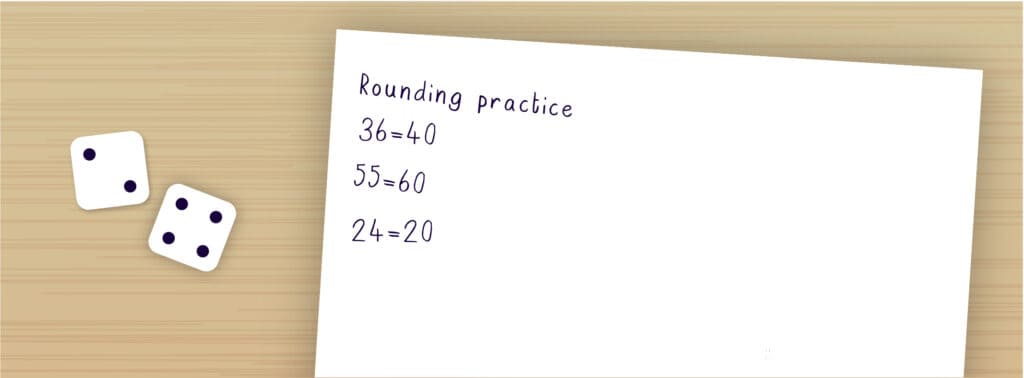
There really isn’t a winner to this easy math activity with dice but it sure does sharpen elementary students rounding skills.
So essentially, everyone wins with this fun math game with dice! 😄
🎲 Don’t have enough dice? That’s ok!
Have players roll that one die as many times as needed to make the two, three (or more) digit number that they will then round.
Make sure that players write down the numbers they roll each time so that they can build the number they will round.
6. Block Out
🔢 Working on: Geometry and Area
😀 Number of Players: 2 or 2 teams
🎲 Number of Dice: 2
📝 Materials: Graph paper and two different coloured pencils
Block Out is one of my go-to fun math games with dice for older students looking for a fun way to practice their area skills.
In this head-to-head geometry game, players will need graph paper, two different coloured pencils, and two dice.
The first player rolls two dice and draws a rectangle anywhere on the graph paper using the numbers rolled as the length and width. They need to colour the rectangle to claim that area with their colour and write the answer inside of their claimed rectangle. The player then writes the math equation for their move on their paper.
Player number two follows the same steps.
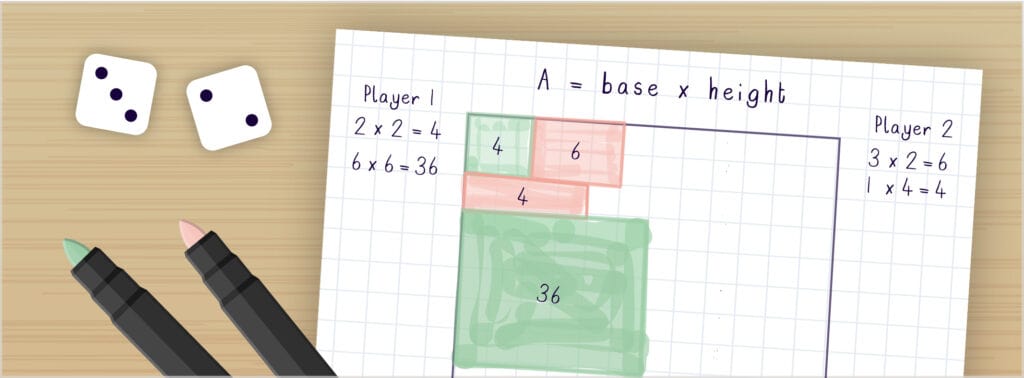
For example, if one player rolls a 3 and a 2 they make a rectangle that is 3 squares by 2 squares on the graph paper, colour it in, and write the answer inside the rectangle. Then they will write 3 x 2 = 6 on their paper.
If the second player rolls a 4 and a 1 then they have to make a rectangle that is 4 squares by 1 square colour it in and write the answer inside. They will need to write their equation with the answer on their paper.
Game play continues until there is no room left to draw any more rectangles. The winner is decided by figuring out the area of each player’s rectangles and adding them together. The player with the most area covered wins.
Now that’s covering a lot of learning!
👏 👏 👏
Aren’t math games just the best?
Well, if you’re enjoying these math games with dice we’re confident you’ll appreciate the Draw, Doodle, Scribble, Think, Create activity book.
Read to know more about why your kids need this fun activity book with unique drawing prompts.
👏 👏 👏
7. Roll a Dollar
🔢 Working on: Number Sense, Money, Addition
😀 Number of Players: 2 or more
🎲 Number of Dice: 2
📝 Materials: Real or fake coins, paper, and a pencil
Students learn about dimes, nickels, and even pennies with this simple math dice game.
You’ll need two dice, real or play coins, as well as paper and a pencil to record results.
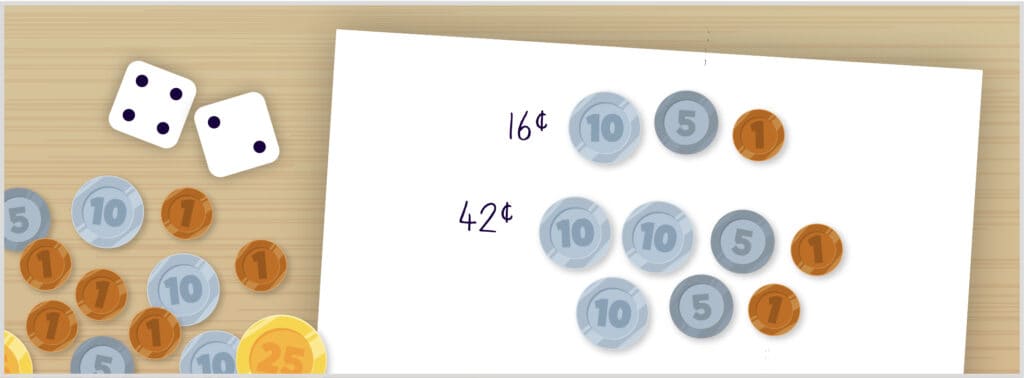
Have participants roll two dice and put them together to make a double-digit number. For example, if they rolled a 2 and a 4, they can make 24 cents or 42 cents. It’s their choice!
Then, have the player make that number using coins and record it on paper. They will add the number from each previous round to the amount in the next round.
🪙 Don’t have coins laying around?
Have students make some coins before you start. Fun!
You can also buy some online, like this handy coin set, or download a freebie such as this one.
Game play continues until someone reaches or passes one dollar!
Roll a Dollar is a great math game that connects kids with money. And it’s great because everyone loves playing with coins!
🎲 Roll Over a Dollar!
Change things up and add a spin to this game by trying to add up to other numbers, like $2.22 for example.
The player that gets that exact amount or passes it first wins. Fun!
8. Stuck in the Mud
🔢 Working on: Number Recognition and Addition
😀 Number of Players: 2 or more
🎲 Number of Dice: 5 total
📝 Materials: Paper and Pencil
You’re going to need five dice for this seemingly complicated but super fun math game with dice. You’ll also need something to keep track of points.
Wait! Before starting, declare how many rounds this game will be played for or choose a specified amount of time for the game to last. Be sure to make those decisions before starting!
For each turn, a player rolls all five dice.
Now, why is this game called stuck in the mud? Don’t worry, there’s no mud involved. It’s because when twos or fives are rolled they are put to the side because, well, they’re stuck in the mud! It’s important to note that no points are rewarded in a round where twos or fives are rolled.
The same player rolls their remaining dice (anything but the twos and fives!). If there are no twos and fives rolled on that second roll, then they add up the numbers on the remaining dice and record that number.
However, if more twos and/or fives are rolled, they are set aside over in the ‘mud’, no points are rewarded, and the remaining dice are rolled.
Play continues until all two or fives are rolled, or the declared amount of rounds or time is reached.
The goal is to have the most points at the end of the game.
As you can see there are a lot of skills learned here, one being following instructions carefully!
✨ Practice mental math with your advanced mathematicians!
Take this game up a notch by NOT using paper and a pencil to record scores.
Have each player add the points up in their heads, say them aloud for the rest to hear, and remember them for the next round.
They’ll need to do this for each round, adding what they role to the score they had from the previous round.
This is a real test for their memory and mental math skills.
9. Pig
🔢 Working on: Addition
😀 Number of Players: Any number
🎲 Number of Dice: 1
📝 Materials: Paper and Pencil for each player
Pig is a great math game with dice for young kids who are just learning addition, as well as older kids who need to brush up on their adding skills.
This math game is a classic that has been around for ages. It can be played with as many players as you like and all you need is one single die, some paper, and a pencil for recording sums.
To play pig, each player takes turns rolling the die. But players beware – you do not want to roll a one! More on that in a bit.
On their turn, the player rolls the die and records the number they’ve rolled. Then they can choose to roll again and add to the points from the previous roll, or they can choose to end their turn and pass the die to the next player.
If they choose to keep rolling, they can roll again and again until they either decide to pass or they roll the number one.
If they pass the die without rolling a number one, then their score is equal to the sum of all the numbers rolled during their turn. The first player to reach 100 (or any other chosen number) wins!
Players want to avoid rolling the number one! If they roll a one, their turn is over AND they lose ALL points accumulated in that round.
🎲 When Pigs Multiply
Add multiplication practice to this game by having players multiply each roll in a round instead of adding.
For example, if a player rolls a 4 on their first roll and a 3 on their second roll they multiply those numbers together to get 12. If they roll a 6 next they will multiply 12 by 6 to get 72.
Then have them add the points from each round together.
Consider increasing the target points for this style of game to 250, 500, or even 1,000!
10. Make Ten
🔢 Working on: Addition and Mental Math
😀 Number of Players: 2 or more
🎲 Number of Dice: 1
📝 Materials: Paper and Pencil for each player
Knowing how to make ten is a very helpful math skill.
All you need for this math game is one die, something to record results, and a small group of students.
In this make-that-number dice game, players take turns rolling one die. The player who rolled the die has to think quickly and say what number is needed to make ten. The number needed to make ten becomes the player’s score for that round.
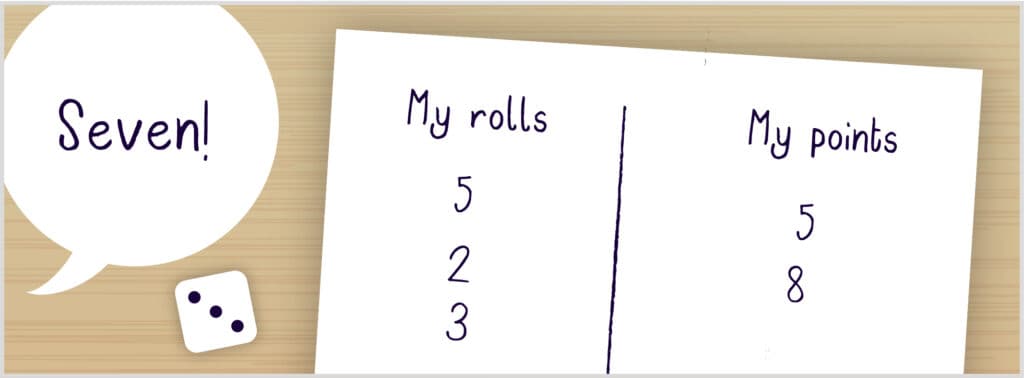
For example, if a player rolls a 3 they need to think of what number added to 3 makes 10. The player says “seven” and receives 7 points for that round.
🎲 Make this game more competitive!
Change things up by having the first person who says the number aloud get the points. If two or more students say it at the same time, they ALL get the points.
Play for a total of ten rounds and have players add up their scores from each round.
The player with the most points wins! But really every player wins because they are honing their basic addition to ten facts.
🎲 Got two dice? Make 100 and make this game 100% harder!
Want to take this game to the next level? Have players roll both dice and create a two-digit number. For example, if they roll a 2 and a 4, they can make 24 or 42. Then have players figure out what number is needed to get to 100.
11. 101 and Done
🔢 Working on: Number Sense and Addition
😀 Number of Players: 2 or more
🎲 Number of Dice: 1
📝 Materials: Paper and Pencil for each player
Roll this one out with your students in pairs, in small groups, or in a teacher vs student style. This math activity with dice will keep players thinking.
Players take turns rolling a die for a total of six rolls. After each roll, students must record the number they rolled.
But here’s where it gets very mathematical! Players have the option of counting each roll as either a unit family number or a tens family number.
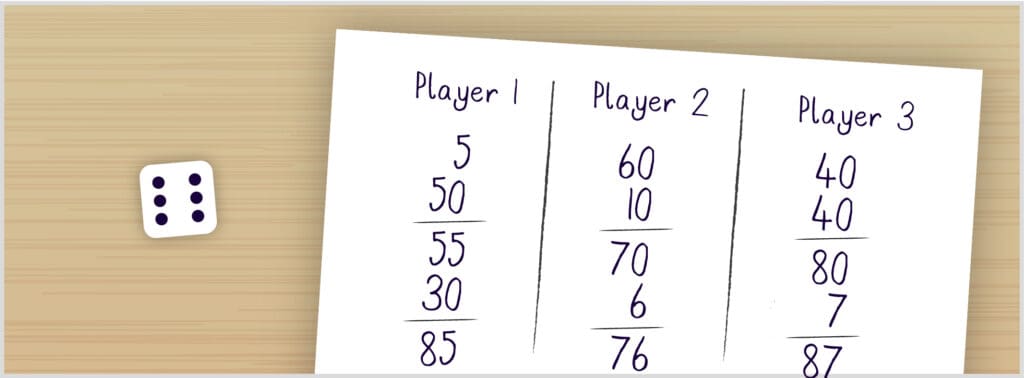
For example, if a six is rolled, it can be recorded as a 6 (unit family) or a 60 (tens family). It’s up to the player after each roll, but once decided upon, that number cannot be changed.
Learners are tasked with keeping a running total from each round as the game progresses.
The goal is to get as close to 101 without going over after completing all six rolls. Hence the name of the game!
That’s right, players will not only improve their number family knowledge but they will also boost their addition skills with each roll.
💡Looking for more Math Games?
You still have 10 more exciting options in this blog, but you might also appreciate these blogs for their great math activities:
9 Montessori-Aligned Math Activities for Your Elementary Classroom
Elevate Elementary Math Skills with This Exciting Math Card Game
Net of a Cube Folding Tutorial + Free Printable and Bonus Game
15 Educational Games With Three Dice for Kids (+ FREE Printable Dice)
21 Fun Math Games with Dice for Kids 8-12 and FREE Printable Dice
12. What’s the Difference?
🔢 Working on: Number Sense and Subtraction
😀 Number of Players: 2 or more
🎲 Number of Dice: 2
📝 Materials: Paper and Pencil for each player
An activity like this helps students become more confident subtractors. They’ll also be pretty proud of their work taking numbers away from one hundred.
Players will roll two dice and make a two-digit number out of them. For example, if they roll a 3 and a 5, they can choose to go with 35 or 53.
Students then need to calculate the difference between the two-digit number they rolled and 100.
They can do this by using mental math or by writing the question down in their notebook, on scrap paper, or on a dry-erase board.
Hey, you can even use a one hundred chart (we have one you can download for FREE) and have students colour in their rolled number to find the difference. Fun!
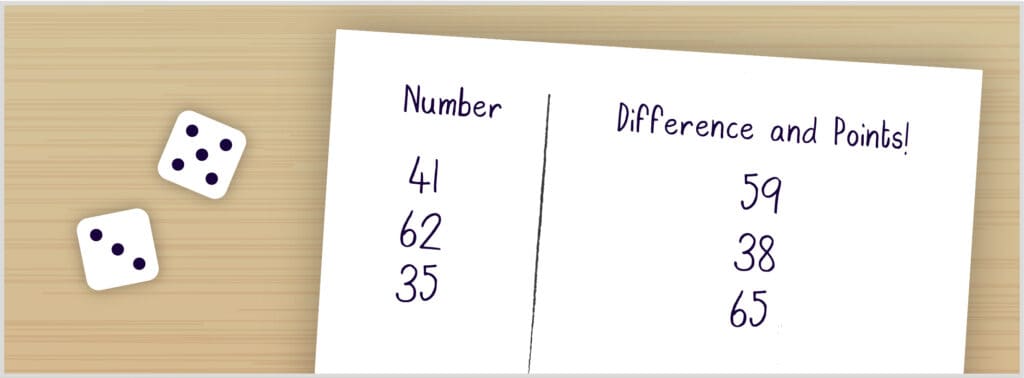
For each round, the score is the difference between 100 and the two-digit number rolled. So to continue with our example above, if the player chose to use the number 35 they would have a score of 65 for that round (100 – 35 = 65).
The player with a score closest to 500 after 5 rounds wins. Or you can keep it going until someone passes 500 and declare them the winner.
And who said subtraction couldn’t be fun?
13. Exponential Learning
🔢 Working on: Exponents and Multiplication
😀 Number of Players: 2 or more
🎲 Number of Dice: 2 (if you have two different-sized dice, that’s even better!)
📝 Materials: Paper and Pencil for each player
For this math dice game, it’s best to have one large die (for the base) and one small die (for the exponent). Or you can use two different coloured dice – one colour for the base and one colour for the exponent.
If you only have two of the same-sized dice, then the first rolled die will be used to represent the base, while the second rolled die will represent the exponent.
Paper and a pencil will be handy for this activity, too!
It’s also best to provide students with a quick review of how to calculate exponents!
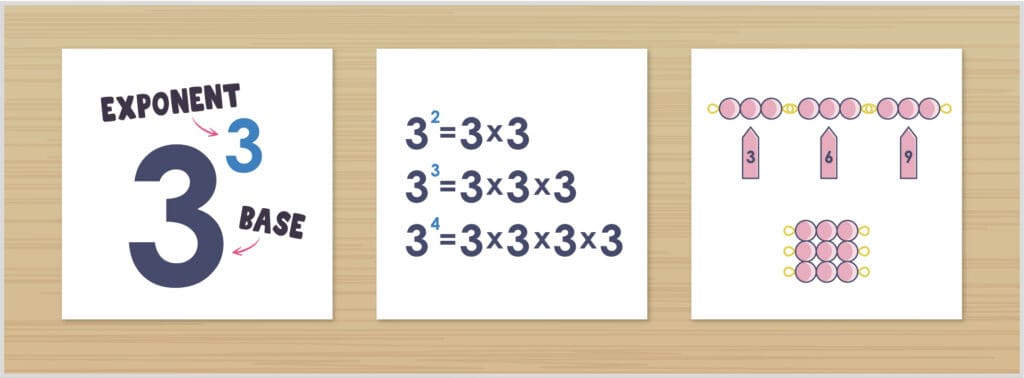
Students will practice calculating exponents by rolling two dice.
After tossing the dice, students record what they rolled in question form and provide the answer. The answer to their question is their score!
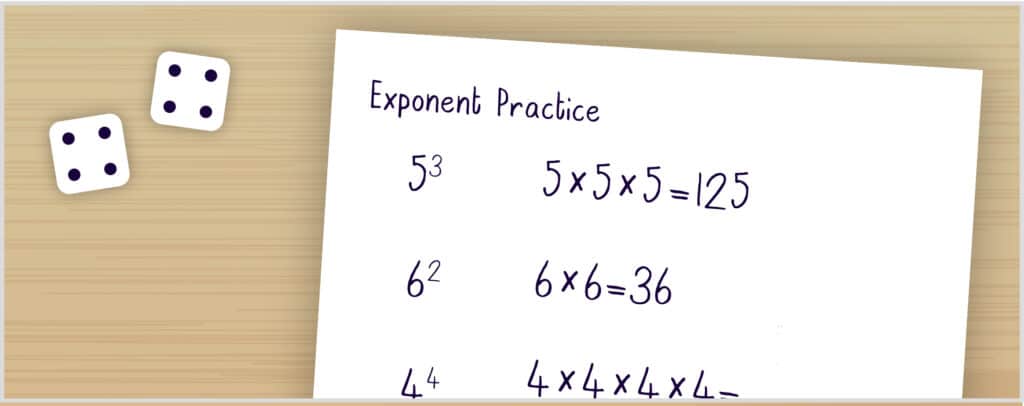
Players need to add the scores from each round together. The player with the most points after 5 rounds wins.
Using two dice to randomly select a base and an exponent is a fun way to take the edge off of learning such a challenging concept.
14. Fraction Frenzy
🔢 Working on: Fractions and Greater Than/Less Than
😀 Number of Players: 2 teams of 2
🎲 Number of Dice: 2
📝 Materials: Paper and Pencil for each player
This game will definitely bring some fun and tangibility to the abstract concept of comparing fractions with the use of dice!
Students work in teams of two and compete head-to-head with another team to see who has the largest fraction.
For this game, players will need paper or whiteboards to display their work.
At the same time, partners from each team each roll one die. With their teammate, they will make a fraction from the numbers rolled. The smaller number rolled should go on top to be the numerator. The larger number will be on the bottom as the denominator.
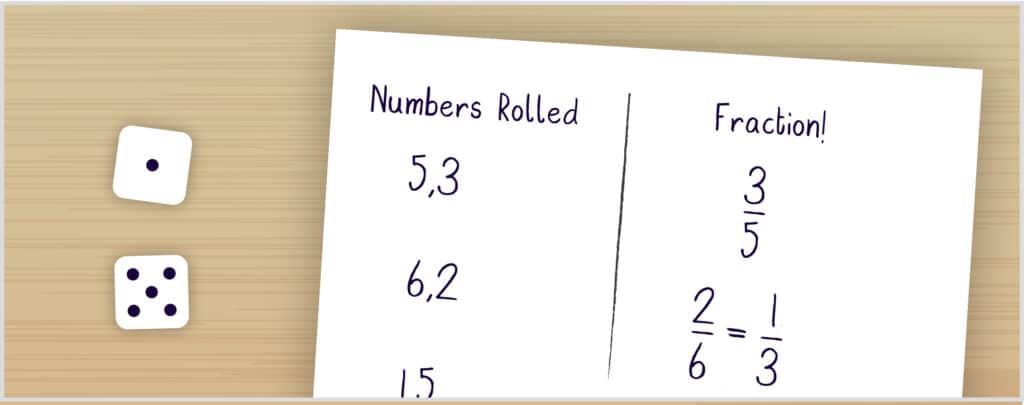
If a team rolls doubles (same number twice, like two fives), that team automatically wins a point for the round because they have rolled a whole number!
Once dice are rolled, partners work together to determine which team has the largest fraction. The team with the larger fraction wins the round and that team gets one point.
Play continues until one team reaches ten points.
15. Fifty
🔢 Working on: Number Recognition Addition
😀 Number of Players: 2 or more
🎲 Number of Dice: 2
📝 Materials: Paper and Pencil for each player
Students will practice their addition skills and patience as they roll their way to matching numbers.
This game requires two dice and can be played with two or more people.
Players need to keep track of their points, so paper and pencil are a must.
Alternating turns, players roll two dice with the goal of rolling doubles to earn points. If doubles are not rolled, the player does not score any points for that turn. And the dice are handed over to the next player.
The object of the game is to roll doubles because that’s how you earn points, well for the most part. Players do not want to land double threes. If double 3’s are rolled all of that player’s points are wiped out. Back to zero!
The first player to reach 50 points wins the game.
Here’s how players score points:
😺 Roll double 1s, 2s, 4s, 5s = 5 points
😻 Roll double 6s = 25 points
🙀 Roll double 3s; their score up to that point is wiped out and they must restart accumulating points from zero.
Double 6’s can finish it off in two rounds! Now that would be impressive.
Check out this demonstration of how to play Fifty:
16. Over the Mountain
🔢 Working on: Addition, Subtraction, Building Equations and Teamwork
😀 Number of Players: Teams of 2
🎲 Number of Dice: 3
📝 Materials: Paper and Pencil for each player
Elementary learners of all ages and abilities are sure to enjoy this mathematical game with dice.
Group students into teams of two and provide each pair of students with three dice and an “over the mountain” diagram that contains the numbers 0-18. Depending on their age and level, they can draw the diagram themselves. Independence!
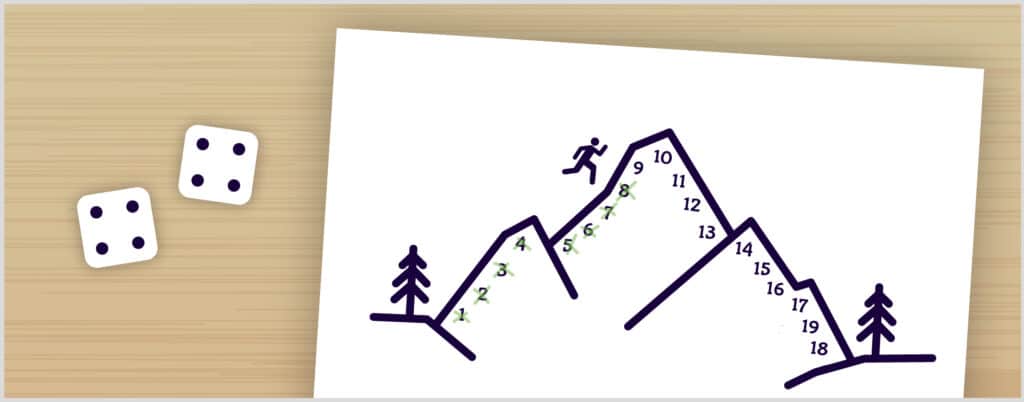
Teams will take turns rolling all 3 dice. They are to work together to add or subtract the amounts shown on the rolled dice and then cross off those sums or differences on their “hill” number line. Depending on the number they’re trying to create next, students will need to think outside of the box to create 2-digit and even 3-digit math equations.
But here’s the catch, numbers can only be crossed off in numerical order starting with 1 so players must work their way up the mountain in order.
Teams can cross off as many numbers as possible in one roll. When they cannot create any more equations to create the next number on their mountain from the rolled dice, their turn is over and the next team gets to roll the dice.
Each team’s turn starts at the number they left off at on the previous turn. For example, if the last equation they created equaled 4 and therefore 4 was crossed off of the mountain diagram, then on their next turn they would start by trying to create an equation that equals 5.
The first team to make it up and over the mountain, reaching 18 wins.
Need an example? Well, follow me here.
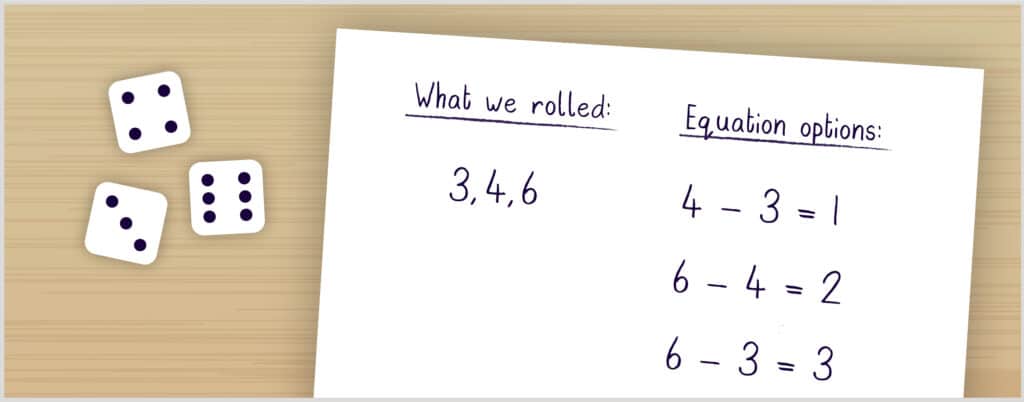
Let’s say a team of players rolls three dice and land on 3, 4, and 6. This pair can cross 1 off of their mountain (4 – 3 = 1). They can also cross off 2 (6 – 4 = 2) and 3 (6 – 3 = 3).
Then they can go through a series of three-digit equations and figure out that (6 + 3 – 4 = 5),(6 + 4 – 3 = 7), (6 + 4 + 3 = 13) and so on. In this case, since a sum or difference of 4 cannot be made, they cannot cross off 4, or any numbers after 4. Game play moves to the next pair.
When their turn comes back around they will start by finding a sum or difference that equals 4 using the numbers from the dice rolled.
✨ Multiply their options!
If your students are more advanced, then consider including multiplication as an operation that teams can use in this game.
For example, if they need to create 10 and roll a 2, 1, and 5 they could create the equation 2 x 5 = 10. Yay math!
17. Multiple Dice
🔢 Working on: Addition, Skip Counting, Multiples
😀 Number of Players: 2 or more
🎲 Number of Dice: 2 or more
📝 Materials: Paper and Pencil for each player
Fun to do in pairs or individually, this is a great challenge for learners of all ages and levels.
This is a great activity for learning about multiples, practicing skip counting, and working on math facts. Some paper, a pencil, and a couple of dice are all you need to play and learn.
Taking turns, students roll 2 (or more) dice and add them together to get the sum. Then they will record and say out loud the first 10 consecutive multiples of that number. Finally, they will add those ten numbers together. The player with the largest sum of 10 consecutive multiples wins that round.
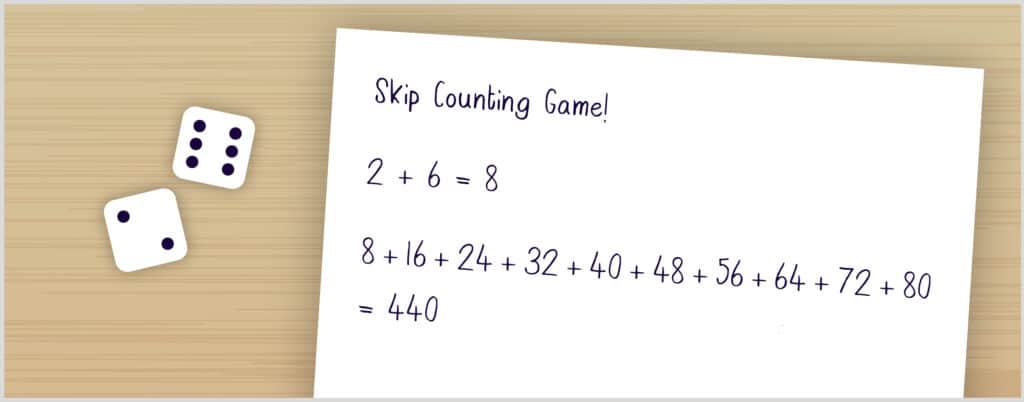
For example, if a player rolls a 6 and 2, they need to add those two numbers together. The sum of 6 and 2 is 8.
Now they will state the first 10 multiples of 8: 8, 16, 24, 32, 40, 48, 56, 64, 72, 80. And to finish it off, they will add those ten numbers together which gives 440. Will that be enough to win?
After each round players add their points together. The player with the most points after four rounds wins.
18. Sequences
🔢 Working on: Addition and Probability
😀 Number of Players: 2 or more
🎲 Number of Dice: 6
📝 Materials: Paper and Pencil for each player
This is one of my all-time favourite math dice games for getting students to enjoy their work with numbers.
This game of chance can be played by two or more players and uses six dice along with paper and a pencil.
While there are no strategic skills required to play, children have the opportunity to practice their addition skills and learn about probability.
On each of their turns players roll all six dice at once.
The goal is to create as long a sequence as they can, always starting with 1.
For example, 1 or 1, 2 or 1, 2, 3 or 1, 2, 3, 4 or 1, 2, 3, 4, 5 or 1, 2, 3, 4, 5, 6.
Points are accumulated depending on how long the sequence is. Refer to the points chart below to see how the scoring works.
If they do not roll a sequence (if the number 1 is not rolled) they do not score any points.
But watch out! Triple ones will trip you up!
If any player’s roll contains three 1s, any previous score that the player has earned reverts to zero, their turn is over, and they pass the dice to the next player. Harsh!
Here’s how players score points:
1️⃣ Roll a 1 = 5 points
2️⃣ Roll a 1 and 2 = 10 points
3️⃣ Roll a 1, 2, and 3 = 15 points
4️⃣ Roll a 1, 2, 3, and 4 = 20 points
5️⃣ Roll a 1, 2, 3, 4, and 5 = 25 points
6️⃣ Roll a 1, 2, 3, 4, 5, and 6 = 30 points
0️⃣ Roll and the number 1 is not rolled = 0 points
1️⃣1️⃣1️⃣ Roll three 1’s (1, 1, and1) = score goes back to zero!
There is only one roll per round. When a player’s roll is over, play continues with the next player.
The goal of this game is to be the first to reach 100 points.
Sound confusing? This video on how to play Sequences might clear the air:
19. Spot the Calculation
🔢 Working on: Addition, Subtraction, Multiplication, and Division
😀 Number of Players: 2 or more
🎲 Number of Dice: 2 (or more)
📝 Materials: Paper and Pencil for each player
Students sharpen their adding, subtracting, multiplying, and dividing skills using the numbers 1 to 6. Something for them to feel proud of!
This game is great for developing mental math skills using the four basic operations. To play you need two players and two (or more) dice.
One player rolls two dice and then creates a math equation using the numbers rolled and one of the four basic math operations. They can choose to add, subtract, multiply, or divide the numbers (if possible).
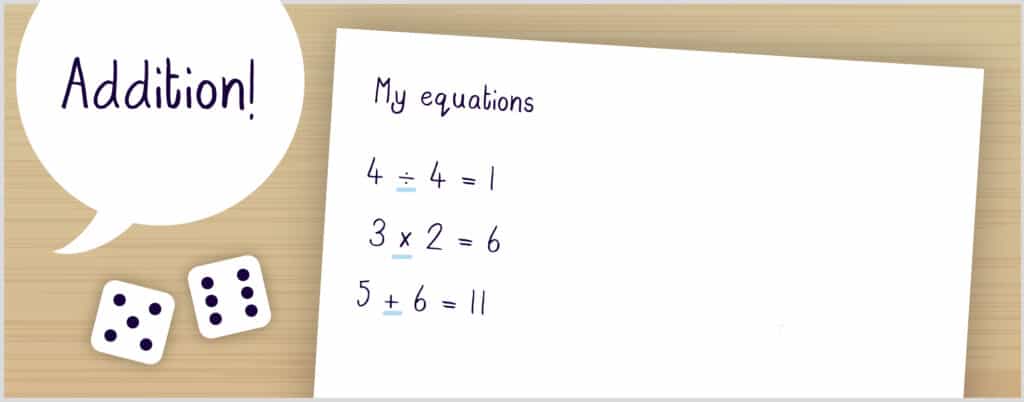
Then they share just the answer of the equation (they keep the equation to themselves!) with the other player.
The other player then has to try and guess what mathematical operation was used to get the answer given.
For example, if one player rolled a 5 and a 6 and says 11, the other player should respond by saying ‘addition’.
Players get a point for stating the correct mathematical operation. The player with the most points after six rounds wins.
✨ Make it more challenging!
Add more dice or give students a time limit to determine the calculation.
If they were using 3 dice and rolled 5, 6, and 2 and state the answer is 16, the other player should respond with ‘multiplication and addition’ because 5 x 2 + 6 = 16.
Throw a timer into the activity and give them 45 seconds to answer the question.
20. Roll Your Way to One Huge Number
🔢 Working on: Number Sens, Place Value, Addition
😀 Number of Players: 2 or more
🎲 Number of Dice: 1
📝 Materials: Paper and Pencil for each player
Since big numbers are exciting to elementary students, this engaging and awe-inspiring math dice game is always a big hit with the inquisitive child in the second plane of development.
For this activity, a die, a group of students, some paper, and a pencil are needed.
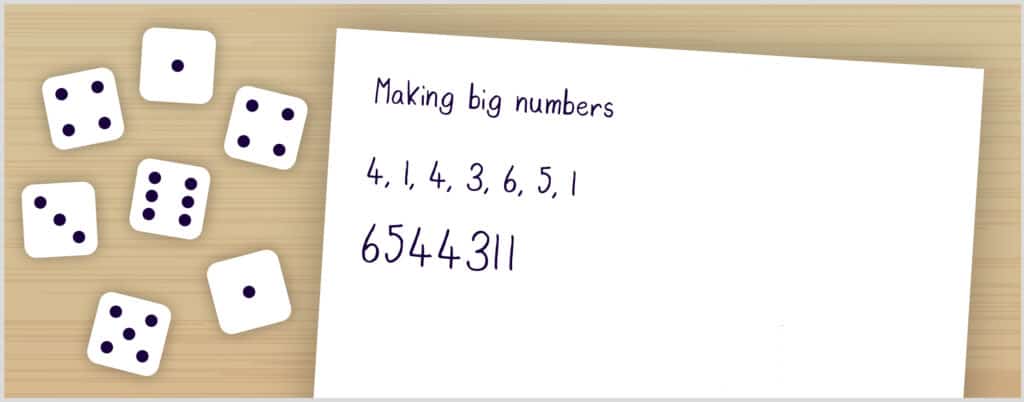
Have students take turns rolling the die and have them write down the number they roll each time. Repeat this seven for 7 rounds.
When all players have rolled the die seven times, they will have 30 seconds to come up with the biggest seven-digit number possible with the numbers they rolled.
The student with the biggest number gets that many points.
The player with the most points after five rounds wins.
✨ Spelling in a Math Game?
Add a challenge and offer to double a player’s earned points if they can properly (or close to properly) spell their seven-digit winning number. Fun!
21. Sums and Quotients
🔢 Working on: Addition, Division, and Observation Skills
😀 Number of Players: 1 or 2 players (can be played in small groups)
🎲 Number of Dice: 2
📝 Materials: Paper and Pencil for each player, Gameboard with division equations
This math game with dice is great for head-to-head competition. Students can challenge each other or a teacher and all they need are two dice, a gameboard for each player (FYI – We created the perfect download for this!), and some coloured pencils or markers.
Alternatively, players can also make the game board themselves on scrap paper. Fun!
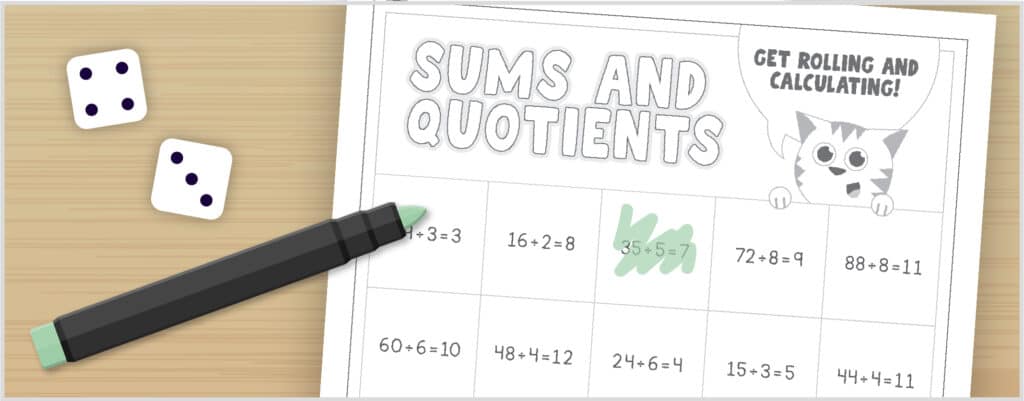
Players will take turns rolling two dice.
During their turn, they will add the two numbers they rolled together to get a sum.
They will then look for the sum on the game board as a quotient. Say what?
Hear me out. If a student rolls a 3 and a 4, they add those two numbers together to get a sum of 7. Now, they shift their focus to the game board and look for the number seven as a quotient (the answer to a division question is a quotient). They can colour in one square with a seven as a quotient.
But be aware, if the sum rolled is already covered as a quotient then no move can be made and the play moves to the next player.
Play continues for a determined amount of time or until one player has covered the most squares with their colour.
Two-Player Challenge!
Have players share one gameboard and see who can colour more squares on the gameboard in their colour. Exciting!
Single Player Mode
This math game with dice can also be played independently. Students can time themselves to see how long it takes to make a vertical, horizontal, or diagonal line. They’ll be excited to beat their time and will want to play
✨🎲 Get your Sums and Quotients gameboards here! 🎲✨
With this no-prep math activity, your students will find fun in math.
This downloadable product includes 8 gameboards with division questions, a blank gameboard for students to create their own equations, and printable dice for an engaging math challenge.
When you add dice to the mix and divide the game cards among your students, math becomes an enjoyable adventure!
Benefits of Math Games With Dice for 8-12-Years-Olds
Math games with dice are a fantastic way to help children in learning math. They’re not only enjoyable but also offer numerous benefits!
🎲 Math dice games make learning math fun for elementary students.
Students connect dice with play and they connect play with fun. When math is fun, students are more likely to engage and retain what they are learning. This is what we call learning in disguise.
Adding math games with dice to your classroom routine will lead to students who are more interested and eager to participate because they are having fun.
🎲 Math games with dice enhance fine motor skills in kids.
As students roll the dice and move them around, they are using and developing their fine motor skills. These are the small muscles in our hands and fingers that allow us to perform intricate tasks such as writing, drawing, and using scissors.
Fine motor skills develop from birth and continue to develop well into adolescence. So it’s never too early or too late to start working on them!
🎲 Math games with dice help kids develop social skills.
Dice games for math can be played with a large or small group of children. When students play in a group setting, they have the opportunity to work on their social skills. They learn how to take turns, follow rules, and even share.
These are important life skills that will help them now and in the future. And all skills are brought to you by playing math games with dice. Imagine that!
🎲 Math dice games teach various concepts
Skills such as addition, subtraction, multiplication, and division can be practiced and mastered using math games with dice.
But there’s so much more that can be taught using dice!
Probability, algebra, order of operations, and even exponents can be explored and practiced using dice.
🎲 Math games with dice boost math skills.
Sure, math games with dice are fun, but they are also capable of boosting academic success! Studies have shown that students who play math games perform better on math tests than those who don’t.
If you’re looking for a way to help your students improve their math performance, math games with dice are a great option!
🎲 Math games with dice sharpen mental math skills.
Mental math refers to doing math calculations in your head without the use of tools such as your trusty pencil and paper.
Being fluent in simple math facts can offer students an advantage in school. By calculating basic math problems mentally, a student’s math fluency can improve, allowing them to move through the math curriculum more easily.
Many of the math games with dice listed above are great for practicing mental math.
🎲 Math games with dice can lead to a love of learning.
When students are engaged and excited about what they’re doing, they are more likely to want to continue learning. And math games with dice have the potential to do just that!
When math is fun and interactive, students are more likely to develop a love of learning. This can lead to a lifetime of academic success.
That’s so Montessori!
So we think you should give math games with dice a try with the elementary learners in your life. You might be surprised at how much your students enjoy them.
And you’ll be even more surprised at how much they learn without even really knowing they’re learning. It’s like math magic!
🙌🏼 The Role of Math Games with Dice in My Classroom
In my classroom, math games with dice make learning enjoyable and effective for everyone. Here are a few reasons why they’re a permanent part of my math curriculum.
🎲 Dice games are an interactive way for children to learn new math skills and solidify old ones.
🎲 Kids take ownership of developing their math facts with dice. There’s something about rolling dice to build a math equation versus looking at a list of questions in a textbook or worksheet. Dice are much more fun!
🎲 Math dice games are a great way to practice complex skills in a fun and relaxed way.
🎲 Learners will want to keep playing more and more rounds, and with all these rounds of practice, math facts are put to memory.
🎲 A variety of math skills can be learned with games using dice. On top of that, social skills such as taking turns, following rules, and being patient are practiced as well.
🎲 Math games with dice can be adjusted to any level of math skill. They are inclusive, adaptable, and a whole lot of fun!
🎲 They are a great way to get students thinking strategically and outside of the box.
🎲 Math can be a difficult subject for some kids to learn. But with the help of fun math games using dice, it can become much easier to understand because it’s much more enjoyable.
Math games with dice for the win!
So whether you’re teaching addition to first graders or exponents to eighth graders, there’s a math game with dice out there for your learners.
Free Printable Dice for Math Dice Games
We’re offering the best printable dice for an enhanced gaming experience, and they’re completely free!
🎲 Download Our FREE Printable Dice For Math Games
Are you ready to get started with these fun math games but don’t have any dice? We’ve got you covered!
Sign up for our newsletter and get access to our free printable dice. Just provide your email address below to get your free download. Then you’ll be part of our learning community and receive monthly newsletters.

With our free printable dice, your students can:
🖍️ Express themselves creatively by colouring the printable dice;
✂️ Practice fine motor skills by cutting out the 2D net;
📦 Improve dexterity by building the 2D net into a cube, which is in fact the dice.
✨ That’s so Montessori! ✨
🎲 Play any of the math games mentioned above!
🖨️ Print these pages for your students and add some geometry to your math games session by teaching them how to build a 3D cube from a 2D net.
Cross-curricular learning in action!
Be creative and have fun exploring all the different ways you can use dice to teach math. Your students will love it and they’ll be learning without even realizing it.
That’s what we call learning in disguise!
If you’re not keen on printable dice, here are some dice available for purchase that might interest you.
Looking to Buy Dice for Math Games? Check Out These Great Options!
Set of 100 Colored Dice
Set of 100 White Dice
Translucent Polyhedral Dice Set
Neon Blackout Dice
Tenzi Dice Game
Foam Dice Set Pack of 36
Dice in Dice Bucket
10 Pack Wooden Dice Set
Classroom Dice Set
Inflatable Dice
The Wrap-Up: Math Games With Dice for Kids 8-12
These 21 dice-based math games offer an engaging way for students to practice and improve their math skills. Versatile and suitable for different group sizes, these games require minimal materials and cater to varying skill levels.
Using dice in math games not only enhances academic performance but also boosts students’ confidence in tackling mathematical concepts.
Ready to roll into a world of learning? Get your free printable dice and experience the educational fun these games offer!
Featured by Twinkl in Maths Week 2024 Activities and Games for Kids
FYI – Dice Games Aren’t Just for Math!
Check out JUST ROLL WITH IT and get the kids (or adults!) in your life moving and laughing with this exciting build-it-yourself dice game.

Students get to take part in colouring and building the dice cubes. This allows them to explore their creative side and strengthen their geometry skills.
Steps to Play Just Roll With It:
✅ Download and print game pages;
✅ Colour the adorable 2D net panels on all three dice;
✅ Cut the 2D nets out for all three dice;
✅ Build all three dice;
✅ Gather students, loved ones, and/or friends;
✅ Roll the dice to create wacky games and lasting memories!
Players will also (secretly) be practicing their math skills as they play. They’ll be tracking time, tallying scores, counting repetitions, and even assessing trajectories, and angles for trick shots. There’s so much learning and fun to be had with this active dice game for kids.
This activity is great for Phys Ed class! It can also be used to fill those extra minutes before lunch or dismissal. You’ll probably want to introduce this game to your household too. It’s just that fun!
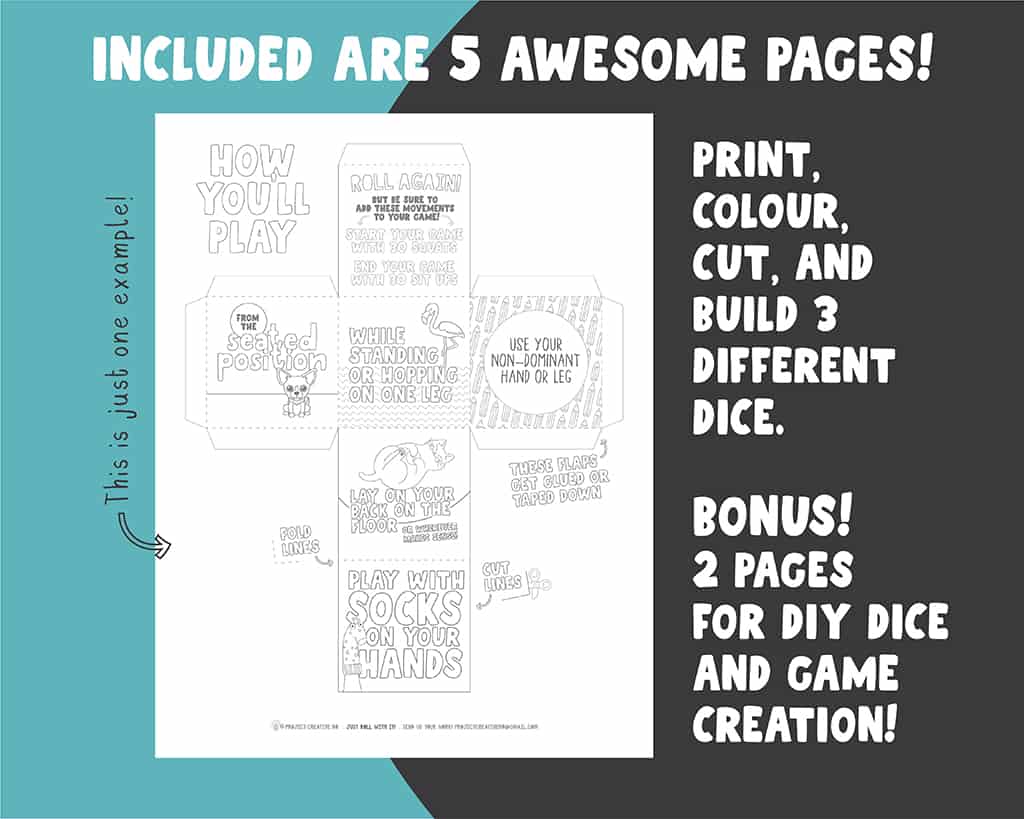
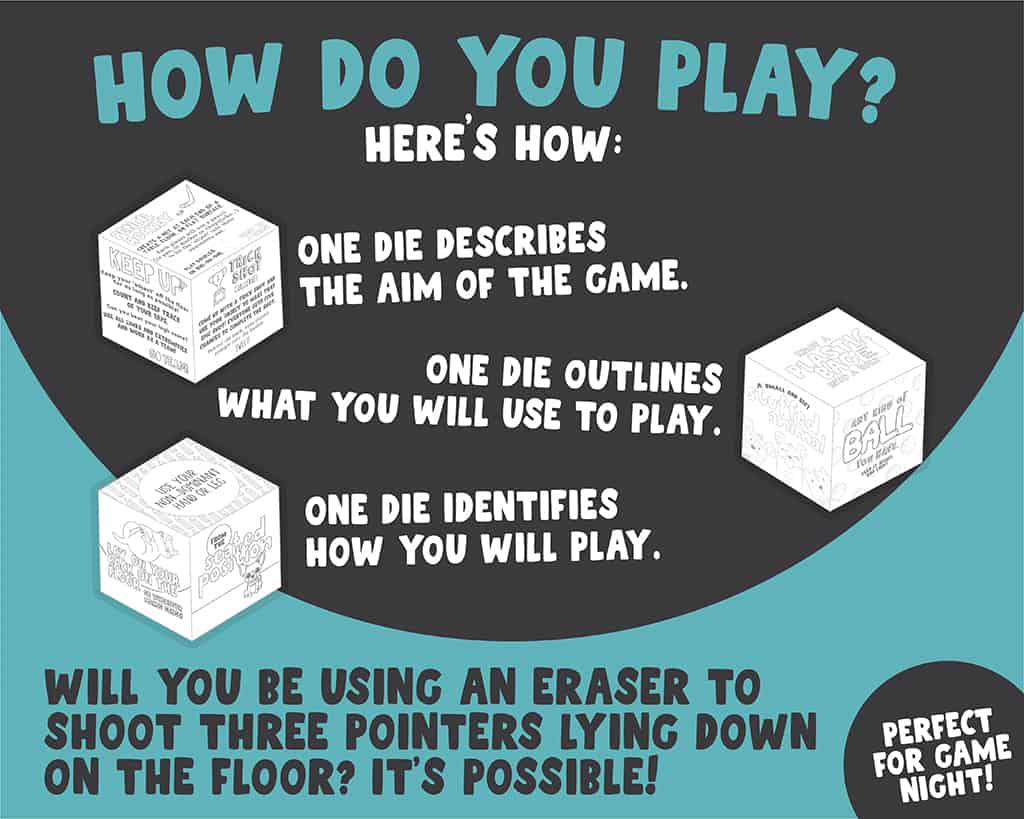
💡These blogs are filled with educational activities:
🎲 15 Educational Games With Three Dice for Kids
🔎 Scavenger Hunt Meets ABCs – A Printable Kids Will Love
🔢 9 Montessori-Aligned Math Activities for Elementary Students
🎲 11 Ways to Use Our Roll A Story Dice Game
🔎 The Ultimate 13 Vocabulary Development Activities for Kids
🌟 Exciting Library Scavenger Hunt Ideas To Do With This Printable
🧩 8 Easy Rebus Puzzles with Answers Plus a Free Printable
💬 13 Fun Ways To Use Quotes In Elementary Learning
💡 Rebus Puzzles for Kids: A Comprehensive Riddle-Solving Guide


